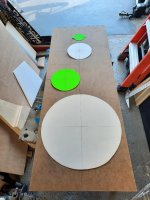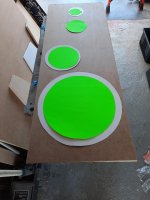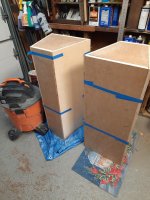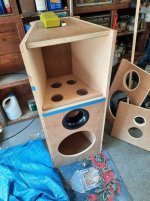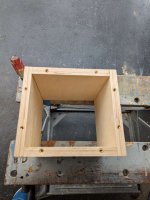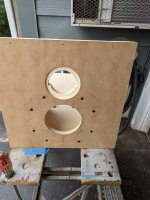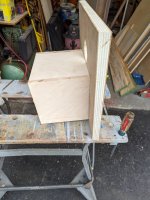I am ready to make measurements of my drivers for a new system (3way). I dont have the actual cabinet yet, only a design. How accurate o representation does the temp baffle have to be? My design is for a 40x14 inch front.
Also since it is a 3 way do I take measurements of (tweet and mid) or( woofer and Mid) etc I dont connect all 3 together do I (as in a 2 way system??)
Also since it is a 3 way do I take measurements of (tweet and mid) or( woofer and Mid) etc I dont connect all 3 together do I (as in a 2 way system??)
About within a quarter to a half of an inch should do fine. You have to measure all units with the mic position unchanged, preferably with off axis measurements
You would probably want to:
(all drivers mounted in cabinet)
No reason to measure any pairs of drivers... and you dont seem to be ready as measuring without a box will be very different from only having a baffle...
//
(all drivers mounted in cabinet)
- measure each driver individually one-by-one without XO (protect the tweeter by starting sweep at say 500 - not to loud!)
- measure each driver individually one-by-one with its intended XO
- measure the whole system with XO.
No reason to measure any pairs of drivers... and you dont seem to be ready as measuring without a box will be very different from only having a baffle...
//
OK I will get the box built then once that is delivered I can proceed with the measurements. Thanks for the guidance.
It depends on your measuring setup and software.
If you are using a USB mic then I think the reason you have measuring tweeter and mid together is to determine acoustic offset. If that is the case then you are correct to do that and would want to also measure tweeter and woofer together, assuming your software is going to look at everything relative to the tweeter. If you have a dual channel measurement setup then you don't need to do this.
If you plan on using VituixCAD then the measurement instructions recommend measuring each driver on its axis, i.e., you WOULD move the mic (but NOT change the volume or anything else). I believe most other programs (PCD for sure) you measure everything on the tweeter axis.
If you are using a USB mic then I think the reason you have measuring tweeter and mid together is to determine acoustic offset. If that is the case then you are correct to do that and would want to also measure tweeter and woofer together, assuming your software is going to look at everything relative to the tweeter. If you have a dual channel measurement setup then you don't need to do this.
If you plan on using VituixCAD then the measurement instructions recommend measuring each driver on its axis, i.e., you WOULD move the mic (but NOT change the volume or anything else). I believe most other programs (PCD for sure) you measure everything on the tweeter axis.
Granted this is a bit older- I was told to measure drivers as a pair NO xo for offset...Is this not true? Also thanks for that information...I almost made just a baffle to start RnD on a build I made a post about.You would probably want to:
(all drivers mounted in cabinet)
- measure each driver individually one-by-one without XO (protect the tweeter by starting sweep at say 500 - not to loud!)
- measure each driver individually one-by-one with its intended XO
- measure the whole system with XO.
No reason to measure any pairs of drivers... and you dont seem to be ready as measuring without a box will be very different from only having a baffle...
//
just curious what if I cant adjust the start sweep frequency? I may be able to nut am unsure I have the Omni Mic V2
yea but I didnt think that your supposed to have any reactive components in the circuit. Thatys easy I just want to make sure my measurements will still be valid. In my system I will be rear mounting my woofer and mid but surface mounting the tweeter. That should cause lots of phase issues lolUse a suitable capacitor as HP filter?
//
Progress Photos. Im getting the feeling I should start a new thread lol
Attachments
The reason to measure all 3 drivers in parallel at a low drive level (0.5v - no more to protect a dome tweeter) is to get exact acoustic Z offset for individual driver measurements where you are not using measured phase response in your crossover simulation.
You basically take your individual driver measurements... and change Z offset until the overall frequency response of the combined individual measurements matches the combined measurement.
You basically take your individual driver measurements... and change Z offset until the overall frequency response of the combined individual measurements matches the combined measurement.
What null? you may not get a perfect null - but you will get a lumpy response and aligning it is all that mattersWouldn't it be better looking for a null?
- Home
- Loudspeakers
- Multi-Way
- Prototype baffle and FRD Measurements
